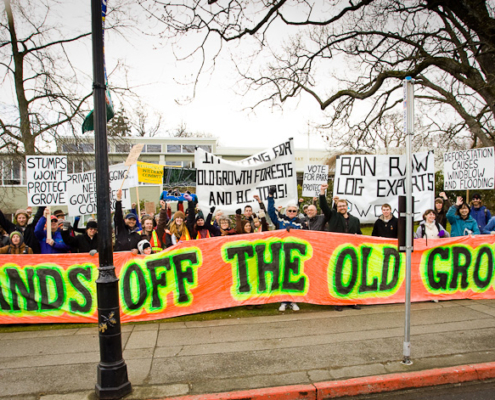
How Many Old Growth Trees Make a Forest?
"They also wondered if TimberWest had tailored a definition of old growth that allowed them to search out and cut the last remaining stands of old forest by calling them second growth. 'How did TimberWest pull that off?' asked Valerie Langer of Forest Ethics Solutions. 'By using a bizarre, technically unheard of, definition they made up.' ...[the local residents] found a recent cut-block full of tall, straight, giant trees dominated by Douglas fir over 500 years old and equally impressive stands of western red cedar. Unfortunately, they claim, the trees were already felled and lying on the ground."

UBC Forestry Forum and Rally – Thursday Jan.23 at UBC
Rally from 3:15 to 4:00 pm at the Martha Piper Fountain, and Forum from 4:30-7:00 pm at the Forest Sciences Center rm.1005, 2424 Main Mall. Pulp, Paper, and Woodworkers of Canada (PPWC) union along with diverse environmental, industry, and First Nations speakers.
Carbon emissions from BC forests alarming: environmental group
“We’re concerned this has become a long-term problem,” said Jens Wieting from environmental advocacy group the Sierra Club. Ideally, a healthy forest will absorb more carbon in the soil and trees than it releases, for example through burning, decomposition and logging. This is sometimes called a carbon sink. Due to a number of factors — including pine beetle infestation, slash fires, wood waste and clear cutting — B.C.’s forests have not done this since 2003, and are emitting carbon dioxide at alarming rates, the group said.

Trees accelerate growth as they get older and bigger, study finds
Most living things reach a certain age and then stop growing, but trees accelerate their growth as they get older and bigger, a global study has found. "This finding contradicts the usual assumption that tree growth eventually declines as trees get older and bigger," said Nate Stephenson, the study's lead author and a forest ecologist with the US Geological Survey (USGS). "It also means that big, old trees are better at absorbing carbon from the atmosphere than has been commonly assumed."

Thanks to Cat Abyss Clothing!
Thanks to Cat Abyss Clothing, a new eco-friendly clothing company who will donate 10% of proceeds to the Ancient Forest Alliance from their kickstarter campaign.
